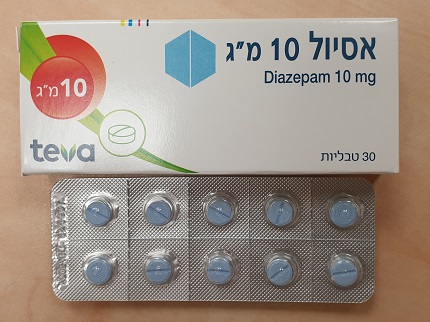Quest for the right Drug

אסיול 10 מ"ג ASSIVAL 10 MG (DIAZEPAM)
תרופה במרשם
תרופה בסל
נרקוטיקה
ציטוטוקסיקה
צורת מתן:
פומי : PER OS
צורת מינון:
טבליה : TABLETS
עלון לרופא
מינוניםPosology התוויות
Indications תופעות לוואי
Adverse reactions התוויות נגד
Contraindications אינטראקציות
Interactions מינון יתר
Overdose הריון/הנקה
Pregnancy & Lactation אוכלוסיות מיוחדות
Special populations תכונות פרמקולוגיות
Pharmacological properties מידע רוקחי
Pharmaceutical particulars אזהרת שימוש
Special Warning עלון לרופא
Physicians Leaflet
Adverse reactions : תופעות לוואי
4.8. Undesirable effects During the first week of administration or when high doses are used they may have a sedative effect and cause some degree of drowsiness. In such cases, there is an advantage in administering half the total daily intake at night, the remainder being given in divided doses during the day. The elderly and debilitated are particularly sensitive to the effects of centrally- depressant drugs and may experience confusion, especially if organic brain changes are present; the dosage of diazepam should not exceed one-half that recommended for other adults. The most commonly reported undesirable effects are drowsiness, reduced alertness and muscle weakness. These phenomena occur predominantly at the start of therapy and usually disappear with prolonged administration. These phenomena occur predominantly at the start of therapy and usually disappear with prolonged administration. Pre-existing depression may be unmasked during benzodiazepine use. Chronic use (even at therapeutic doses) may lead to the development of physical and psychological dependence (see 4.4 Special warnings and special precautions for use). Skin and subcutaneous tissue disorders Allergic reactions (skin rash or itching) occur rarely. Central and peripheral nervous disorders Sedation, unsteadiness, ataxia is common (these effects are dose-related and may persist into the following day even after a single dose), light-headedness, headache, vertigo, dystonic effects occur rarely. Impaired motor ability, dizziness, tremor, dysarthia, slurred speech. Vision disorders Blurred vision. Diplopia Visual disturbances occur rarely. Psychiatric disorders Libido fluctuations (increase or decrease in libido) occur rarely. Depression. Benzodiazepines may induce anterograde amnesia (amnesia may be associated with inappropriate behaviour, see 4.4 Special warnings and precautions for use), concentration difficulties, abnormal psychological reactions, behavioural adverse effects include paradoxical aggressive outbursts, excitement, confusion, restlessness, agitation, irritability, aggressiveness, delusions, rages, nightmares, hallucinations, psychoses, inappropriate behaviour, numbed emotions, the uncovering of depression with suicidal tendencies and dependence (see section 4.4). Other adverse behavioural effects are known to occur when using benzodiazepines (see 4.4 Special warnings and precautions for use). Abuse of benzodiazepines has been reported. Gastro-intestinal system disorders Hypersalivation, gastrointestinal disturbances, constipation, nausea, dry mouth. Gastrointestinal upsets occur rarely. Hepatobiliary disorders Jaundice occurs rarely. Very rarely elevated transaminases and alkaline phosphatases. Endocrine disorders Gynaecomastia. Cardio disorders Hypotension occurs rarely. Respiratory system disorders Respiratory depression, apnoea. Blood disorders Blood dyscrasias occur rarely. Urinary system disorders Urinary retention occurs rarely. Incontinence General disorders Fatigue most commonly reported. Anaphylaxis. The elderly and patients with impaired hepatic function will be particularly susceptible to the adverse effects listed above. It is advisable to review treatment regularly and to discontinue use as soon as possible. Discontinuation of therapy may result in withdrawal or rebound phenomena. Withdrawal effects Withdrawal symptoms: Development of dependence is common after regular use, even in therapeutic doses for short periods, particularly in patients with a history of drug or alcohol abuse or marked personality disorders. Discontinuation of the therapy may result in withdrawal or rebound phenomena (see 4.4 Special Warnings and Special Precautions for Use). Symptoms of benzodiazepine withdrawal include anxiety, depression, impaired concentration, insomnia, headache, dizziness, tinnitus, loss of appetite, tremor, perspiration, irritability, perceptual disturbances such as hypersensitivity to physical, visual, and auditory stimuli and abnormal taste, nausea, vomiting, abdominal cramps, palpitations, mild systolic hypertension, tachycardia, and orthostatic hypotension. Rare and more serious symptoms include muscle twitching, confusional or paranoid psychosis, convulsions, hallucinations, and a state resembling delirium tremens. Broken sleep with vivid dreams and increased REM sleep may persist for some weeks after withdrawal of benzodiazepines. Reporting of suspected adverse reactions Reporting suspected adverse reactions after authorization of the medicinal product is important. It allows continued monitoring of the benefit/risk balance of the medicinal product. Any suspected adverse events should be reported to the Ministry of Health according to the National Regulation by using an online form: https://sideeffects.health.gov.il

שימוש לפי פנקס קופ''ח כללית 1994
Anxiety & tension, neurotic states, skeletal muscle spasm
תאריך הכללה מקורי בסל
01/01/1995
הגבלות
תרופה שאושרה לשימוש כללי בקופ'ח
מידע נוסף
עלון מידע לצרכן
19.07.21 - עלון לצרכן אנגלית 19.07.21 - עלון לצרכן עברית 19.07.21 - עלון לצרכן ערבית 08.06.23 - עלון לצרכן עברית 27.10.23 - עלון לצרכן אנגלית 27.10.23 - עלון לצרכן עברית 27.10.23 - עלון לצרכן ערבית 07.01.21 - החמרה לעלון 07.01.21 - החמרה לעלון 11.01.21 - החמרה לעלון 19.07.21 - החמרה לעלון 08.06.23 - החמרה לעלוןלתרופה במאגר משרד הבריאות
אסיול 10 מ"ג